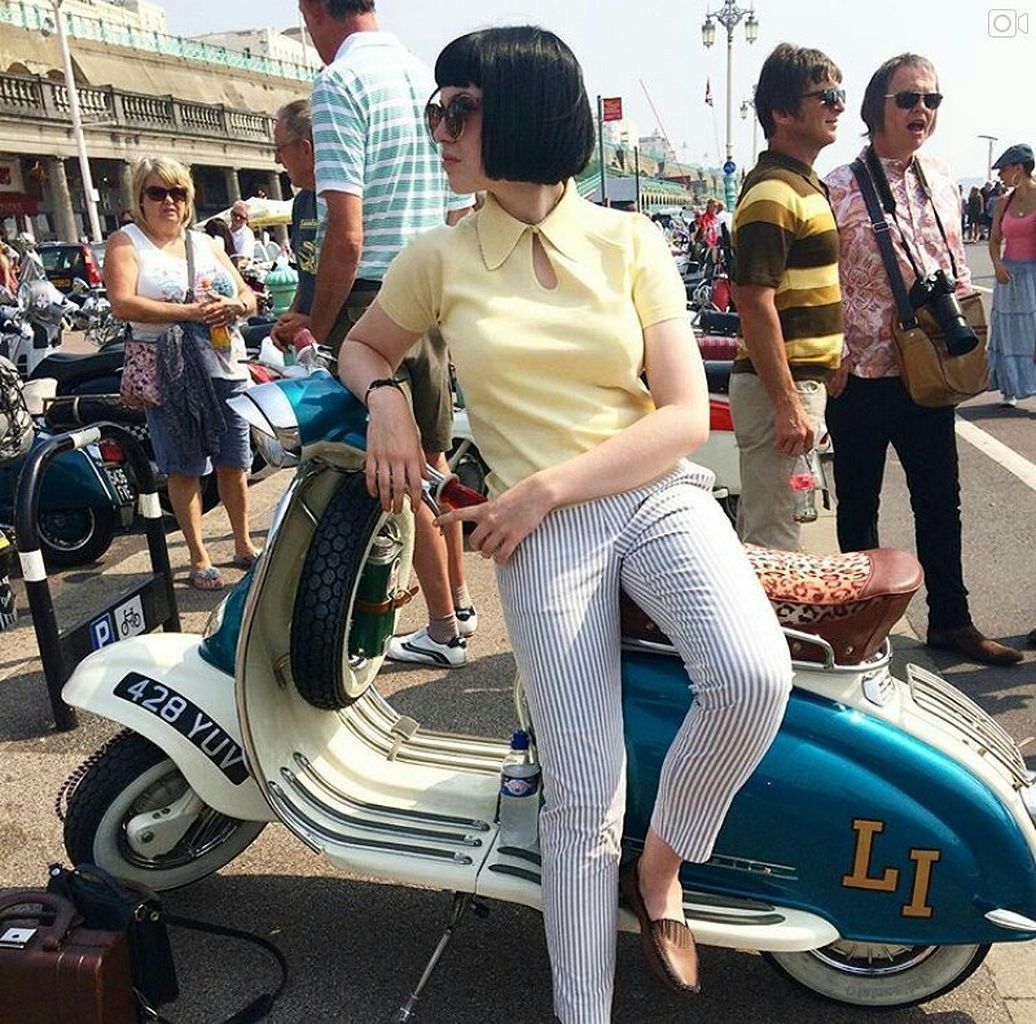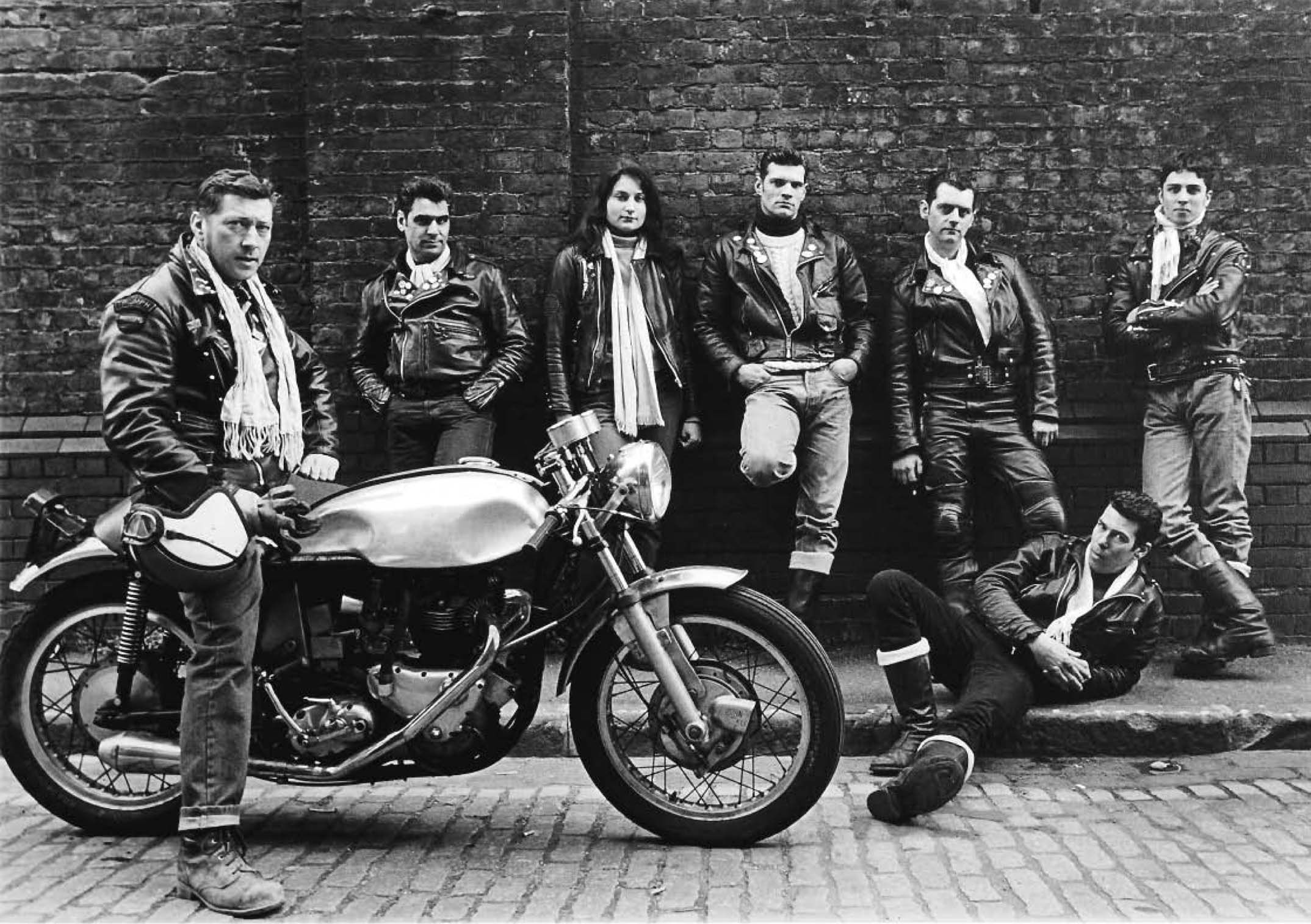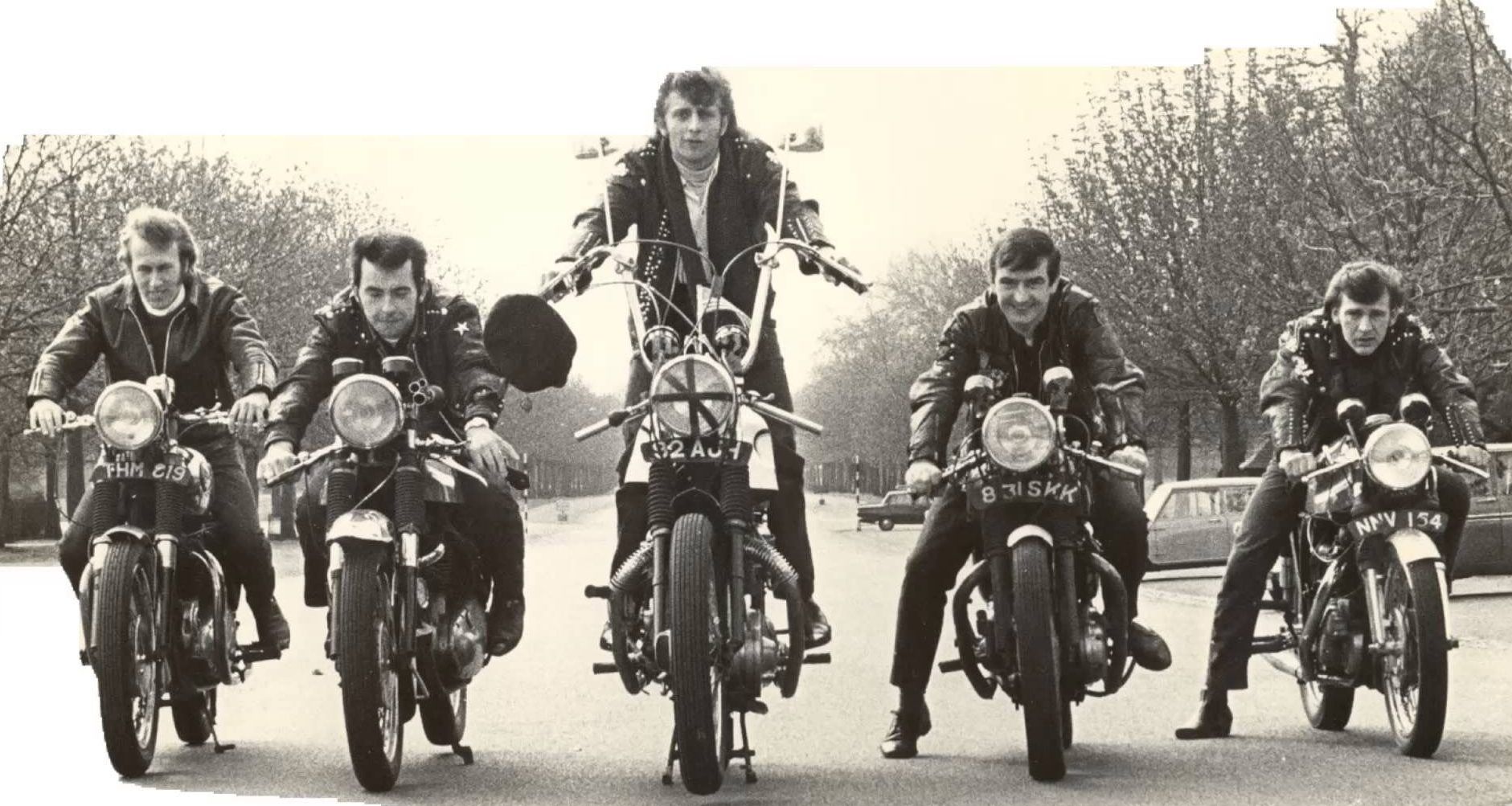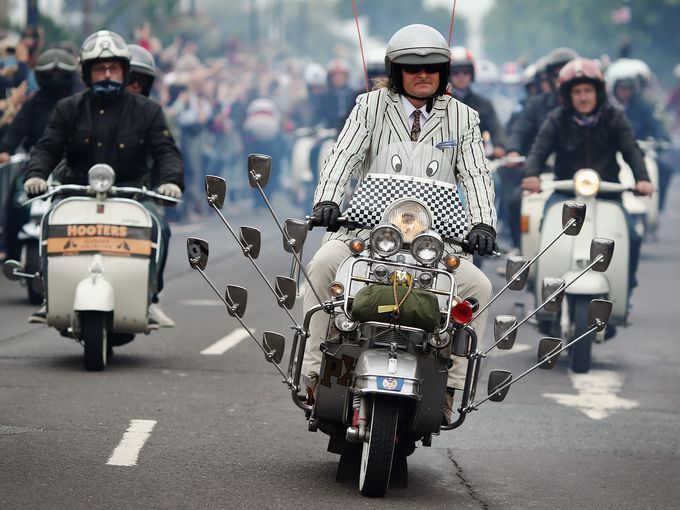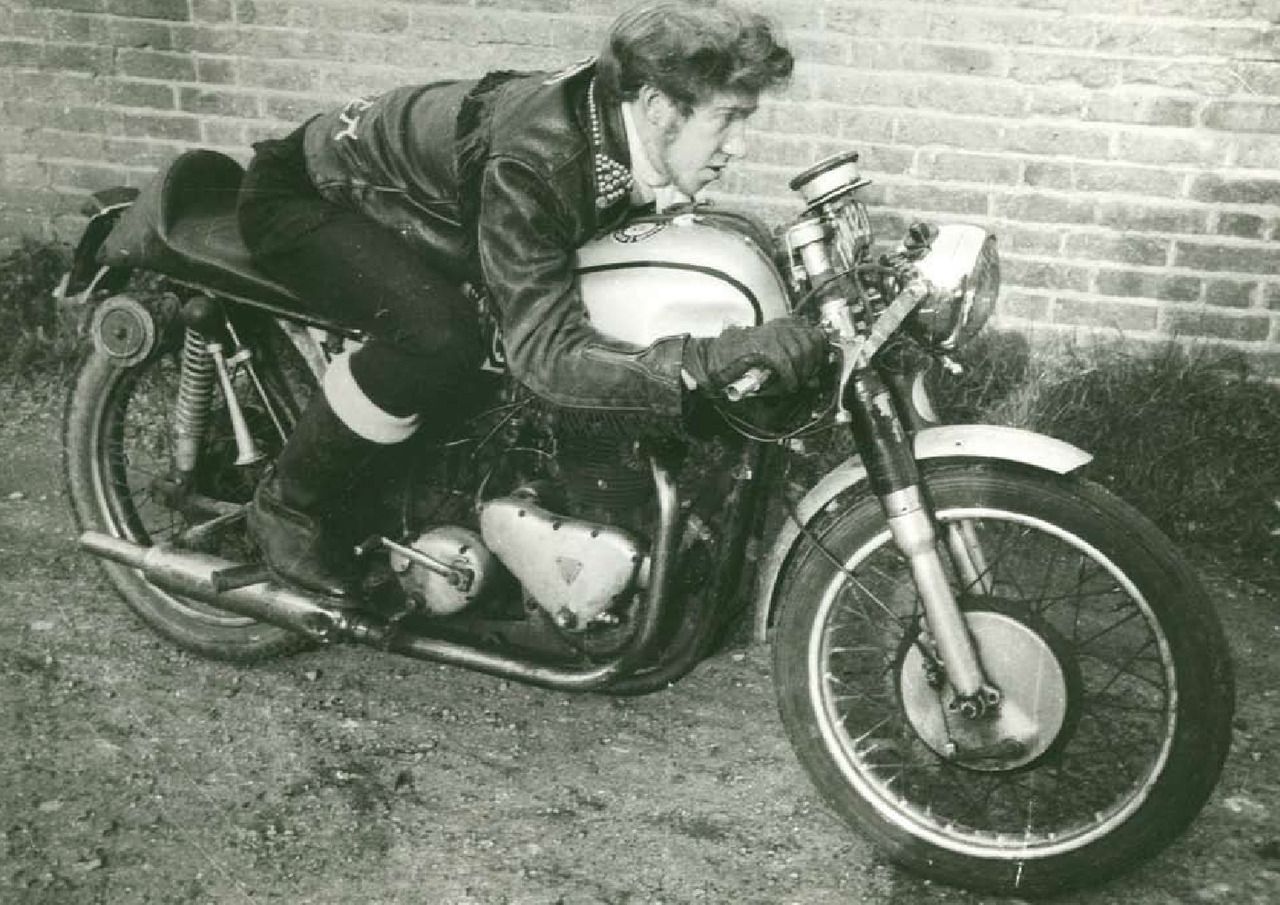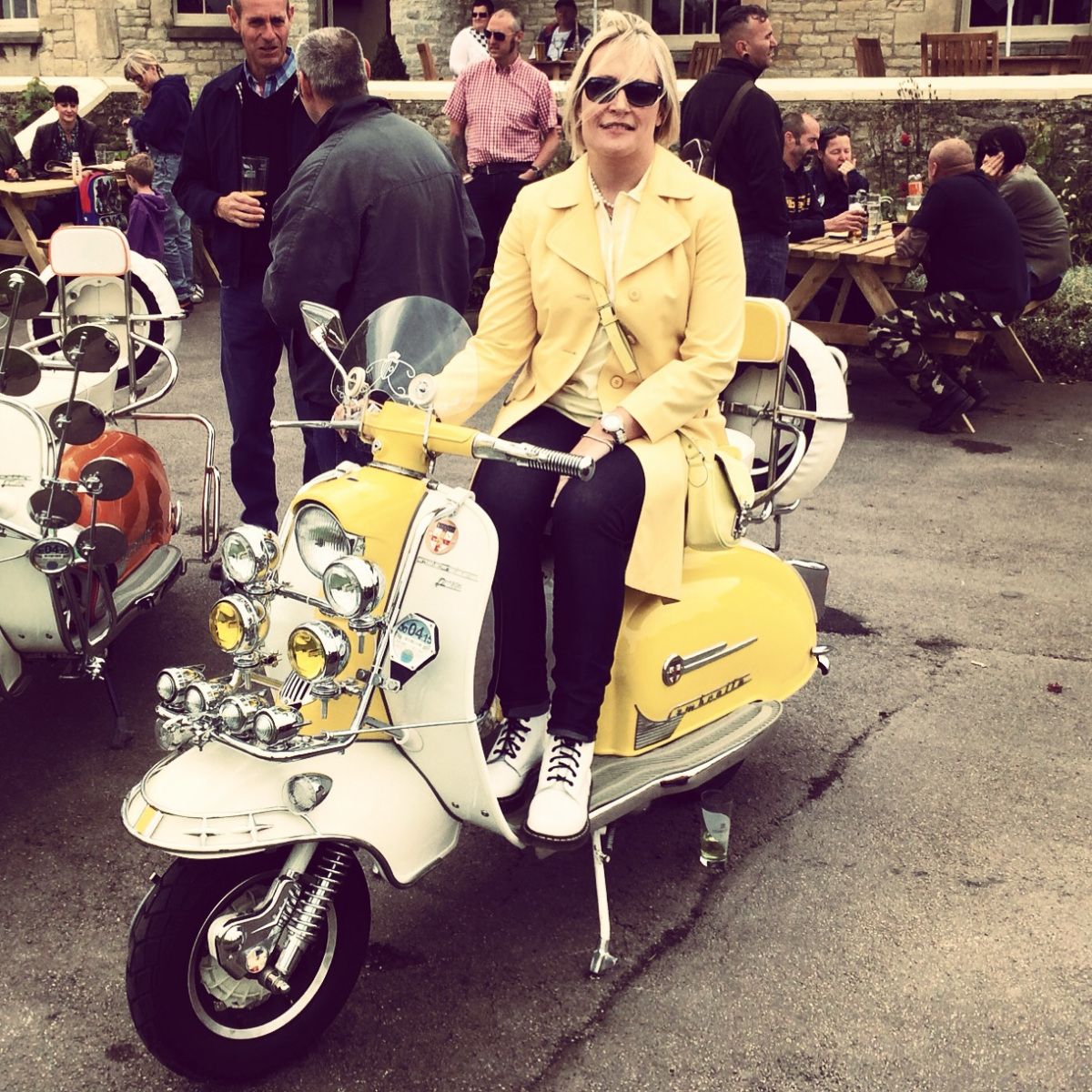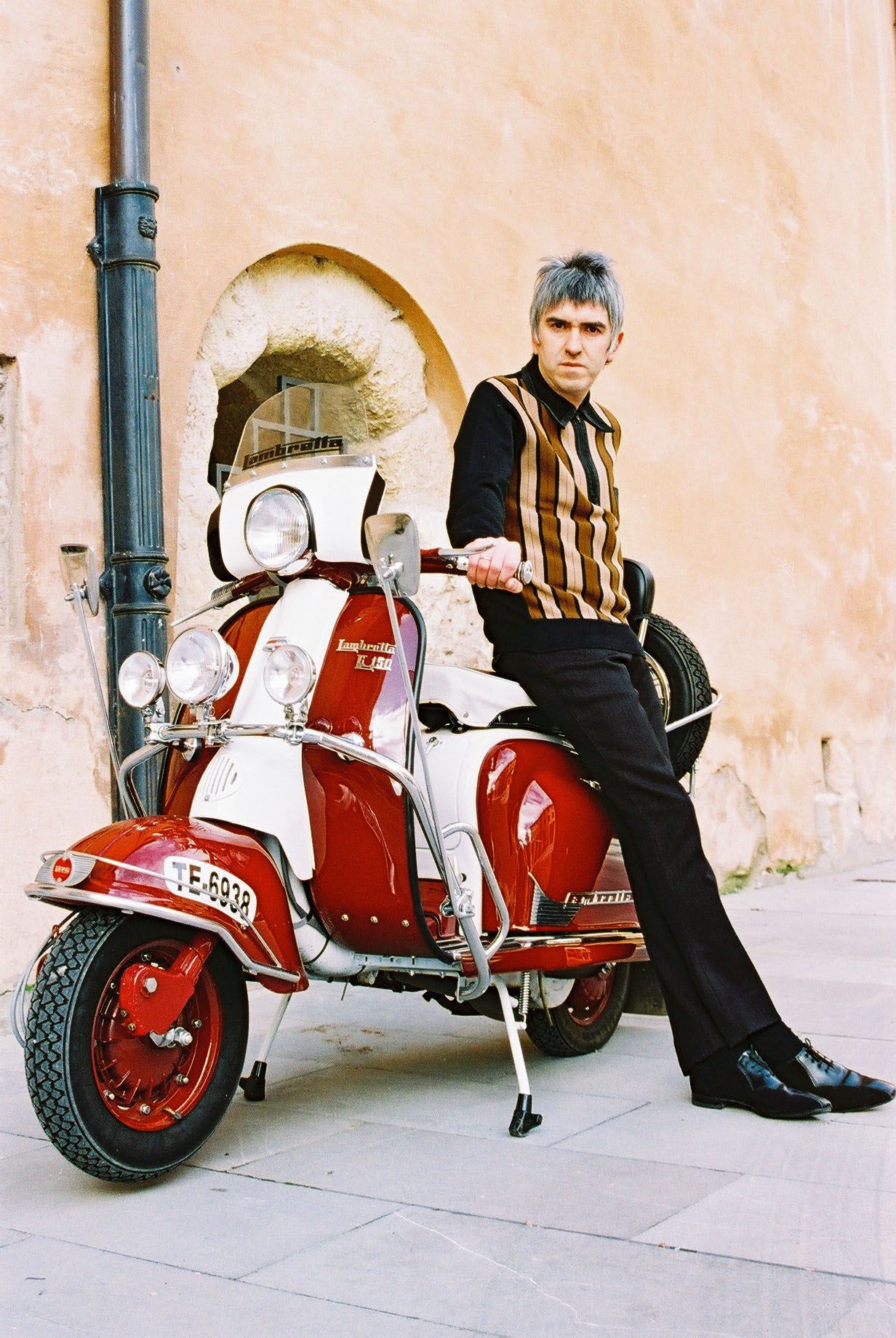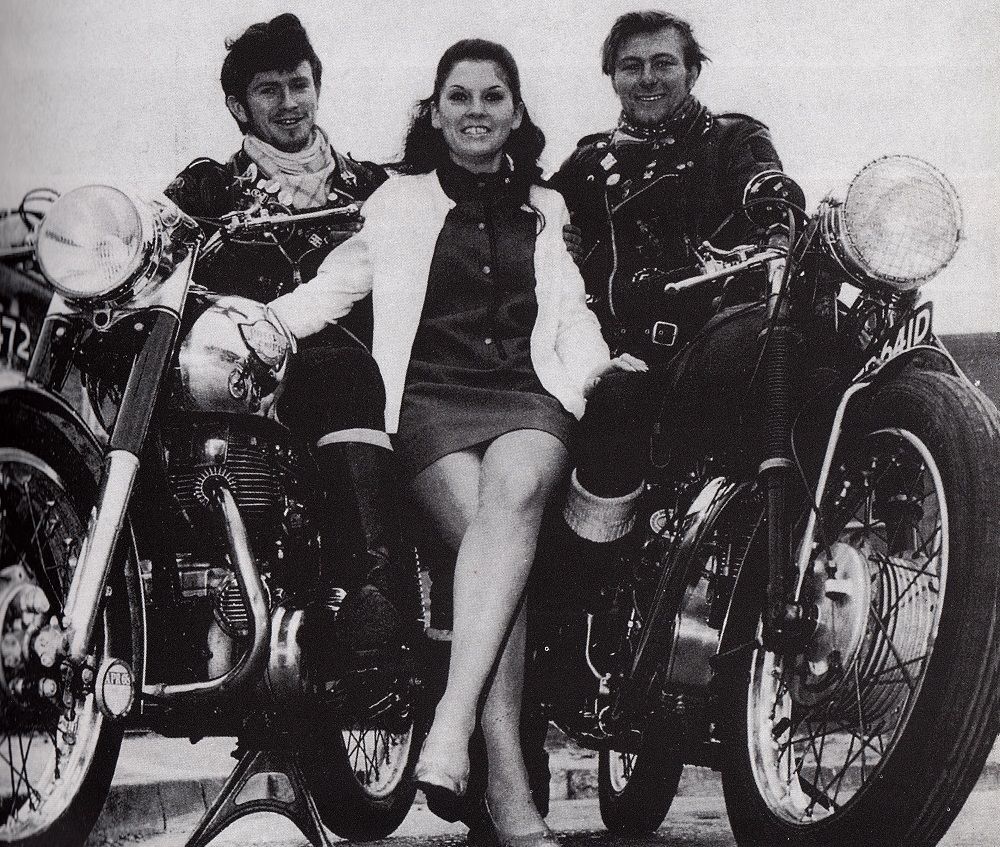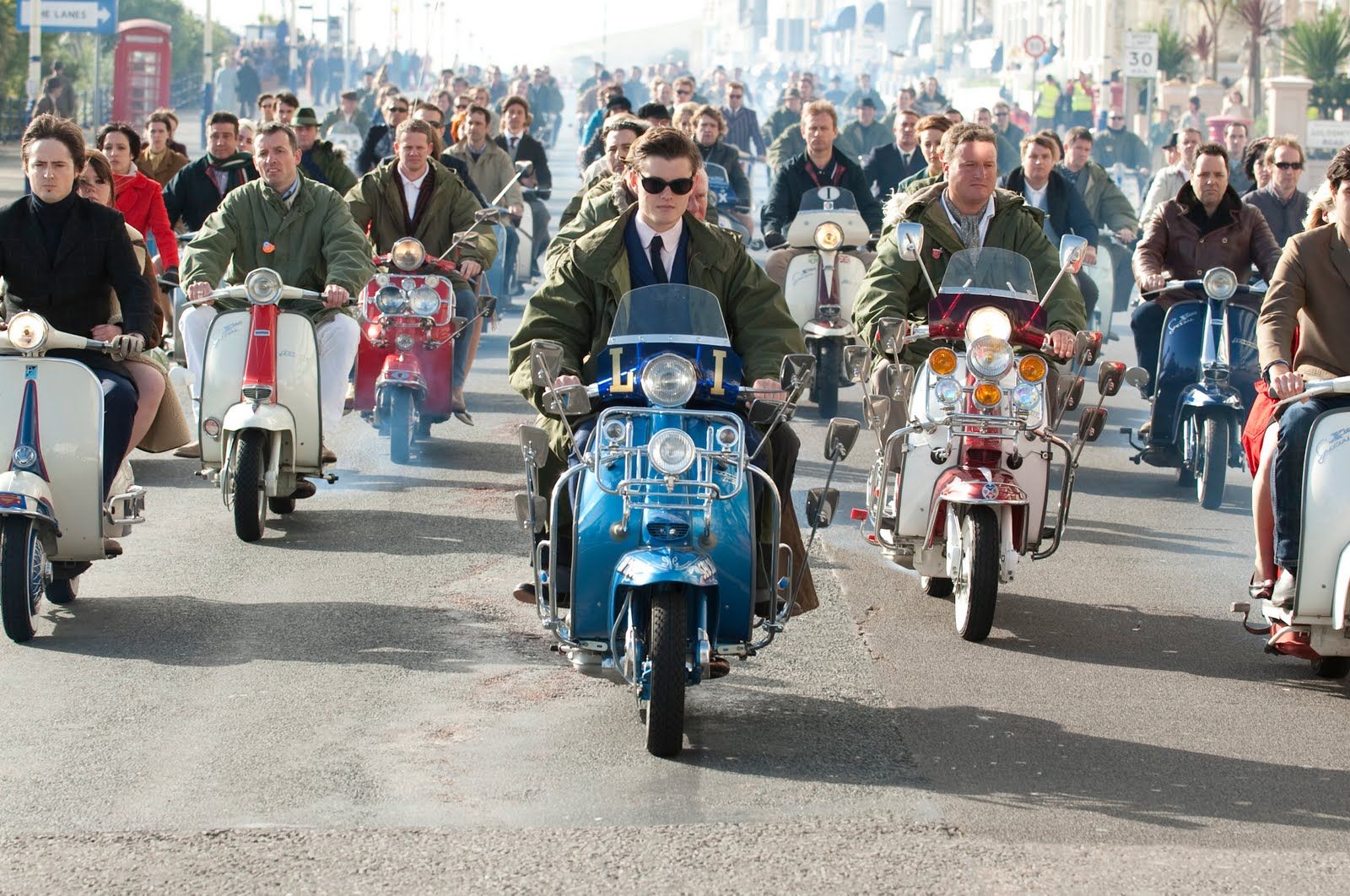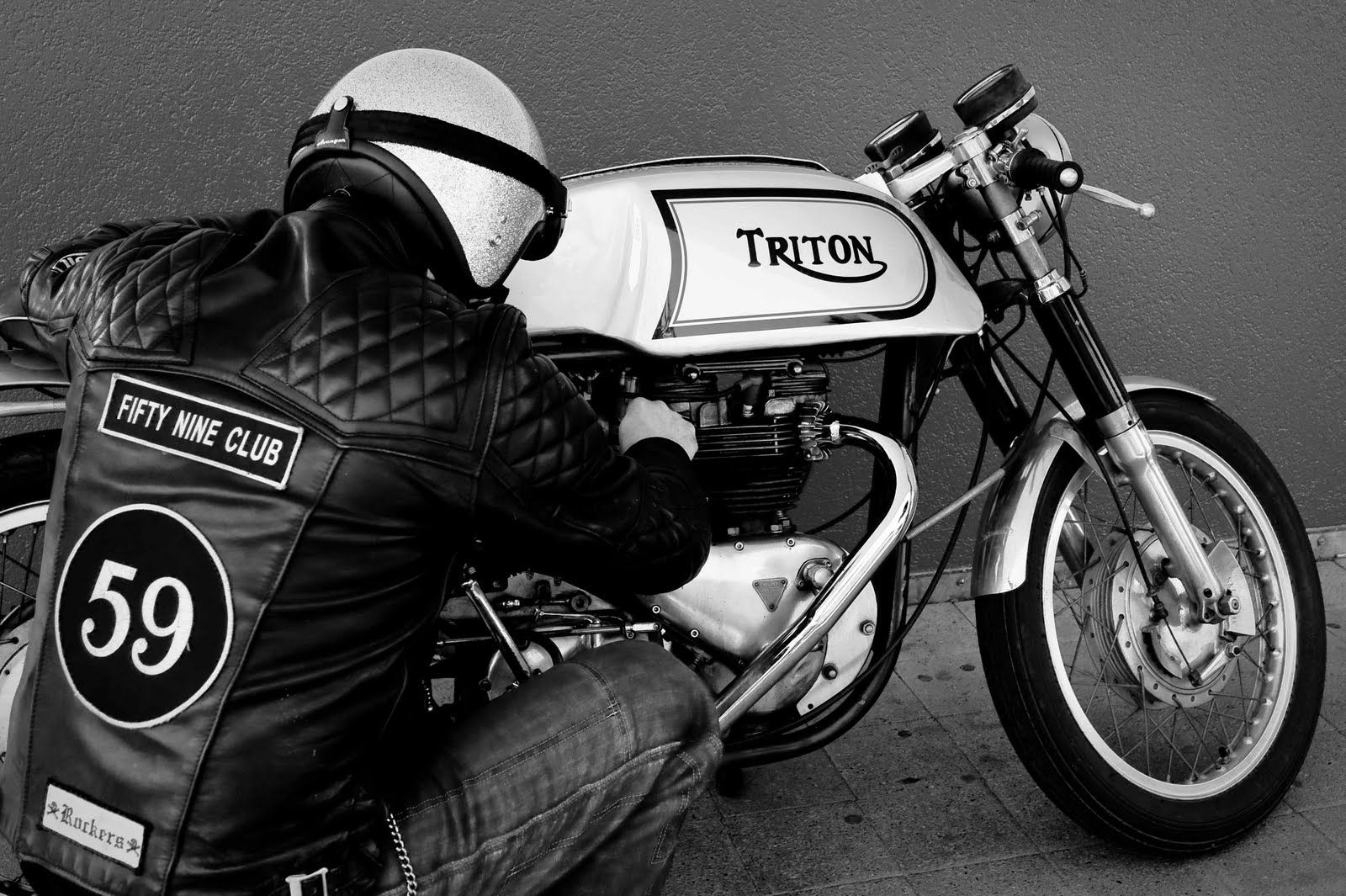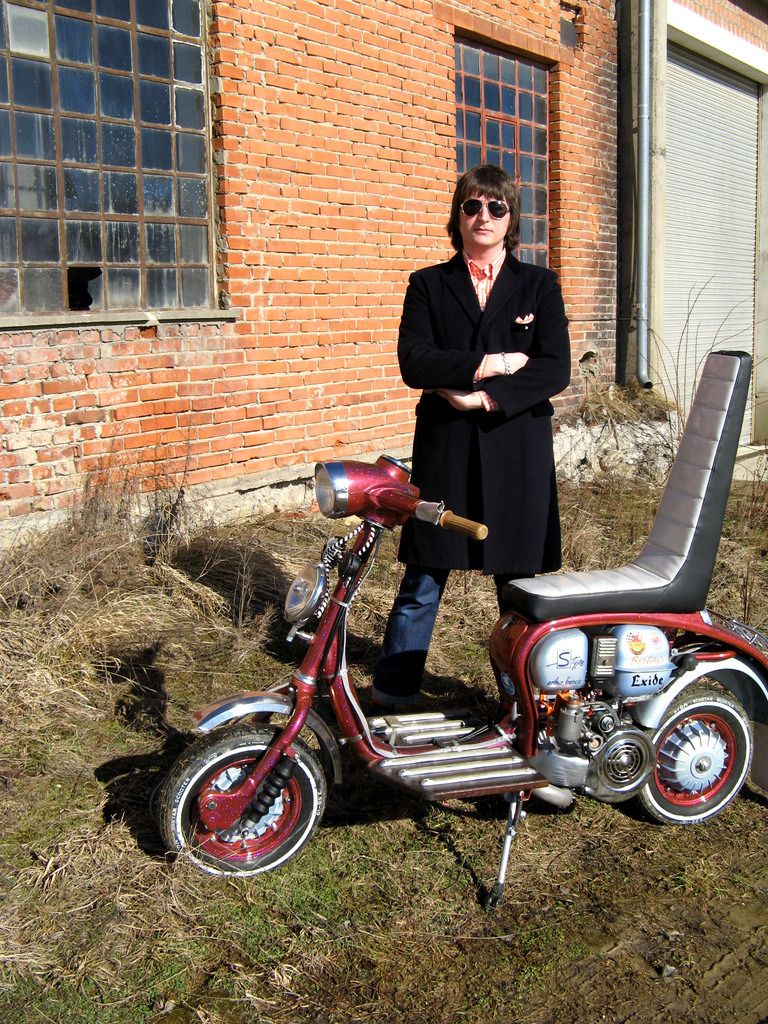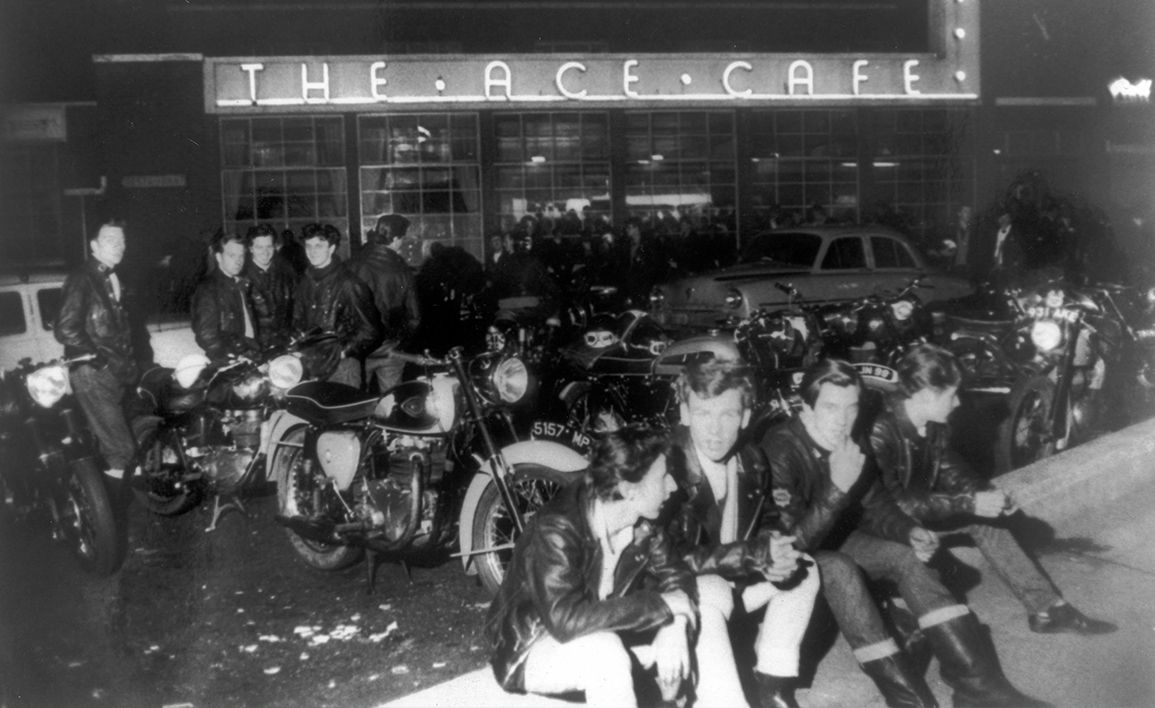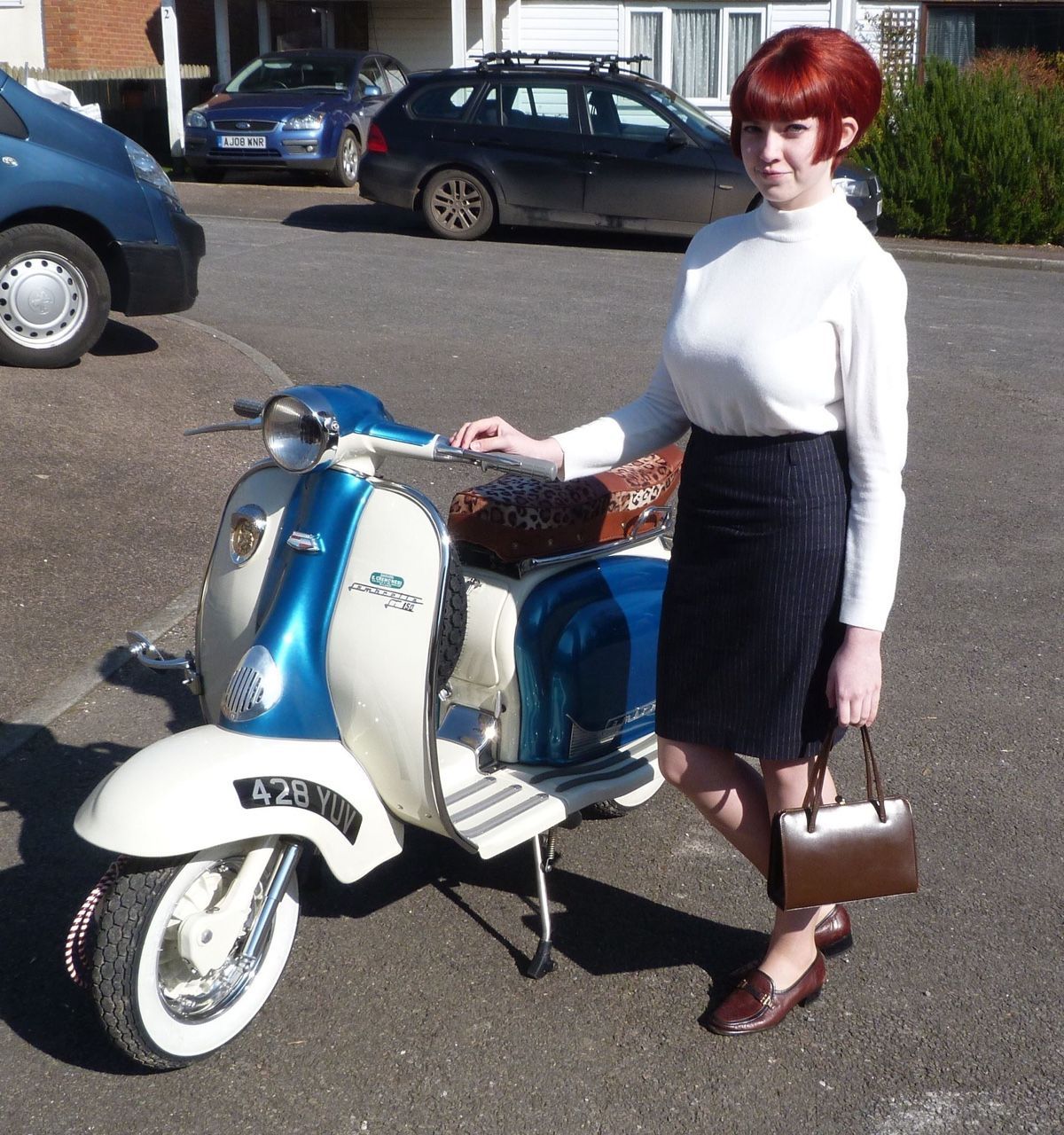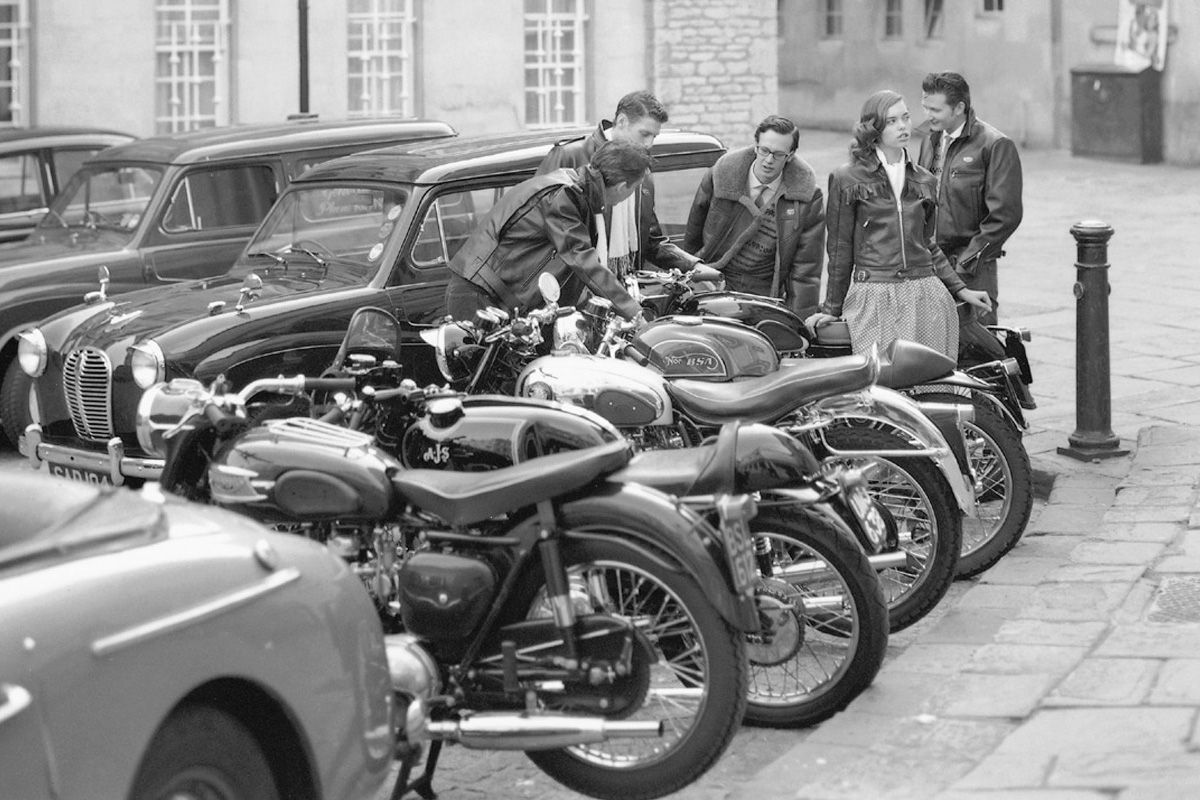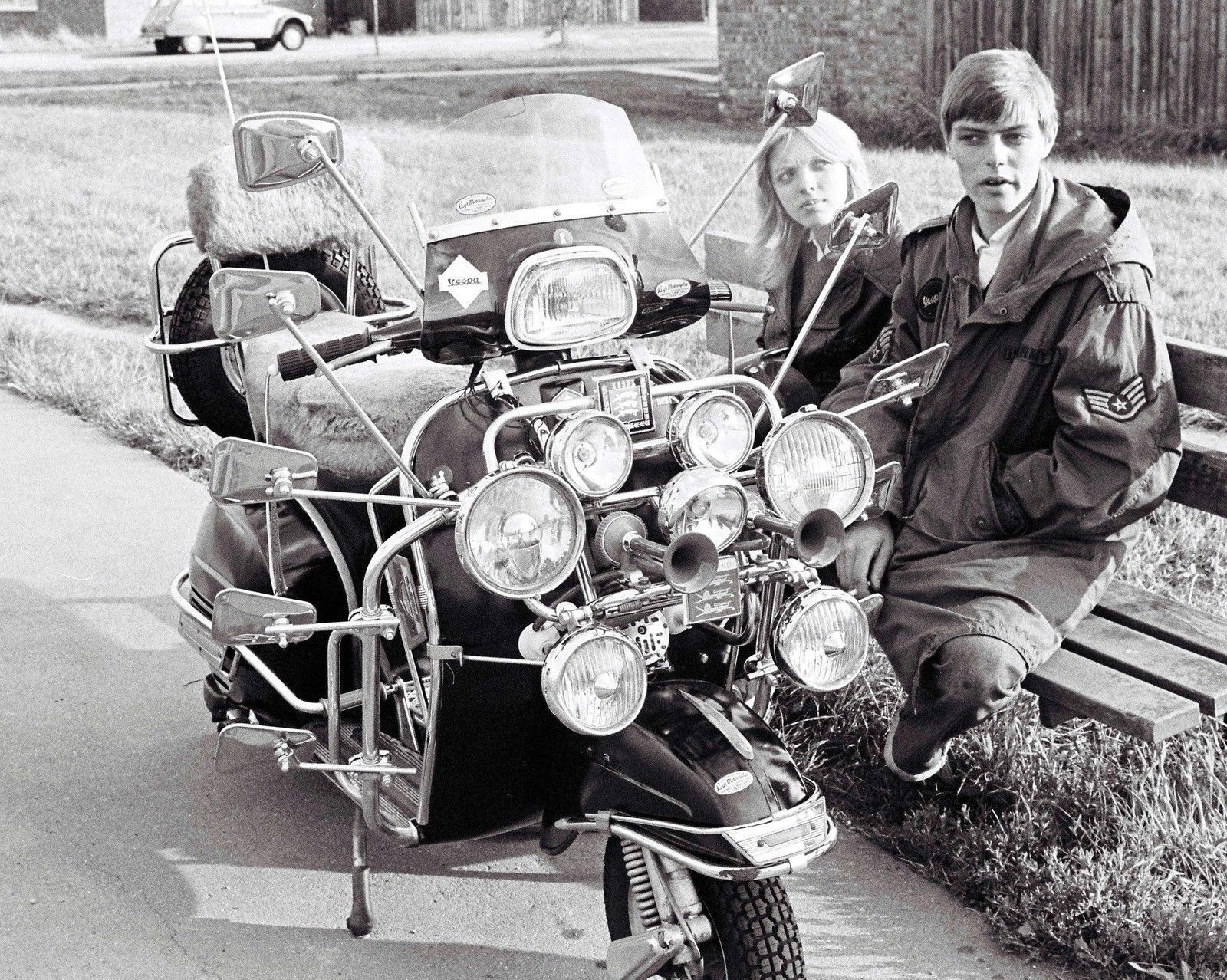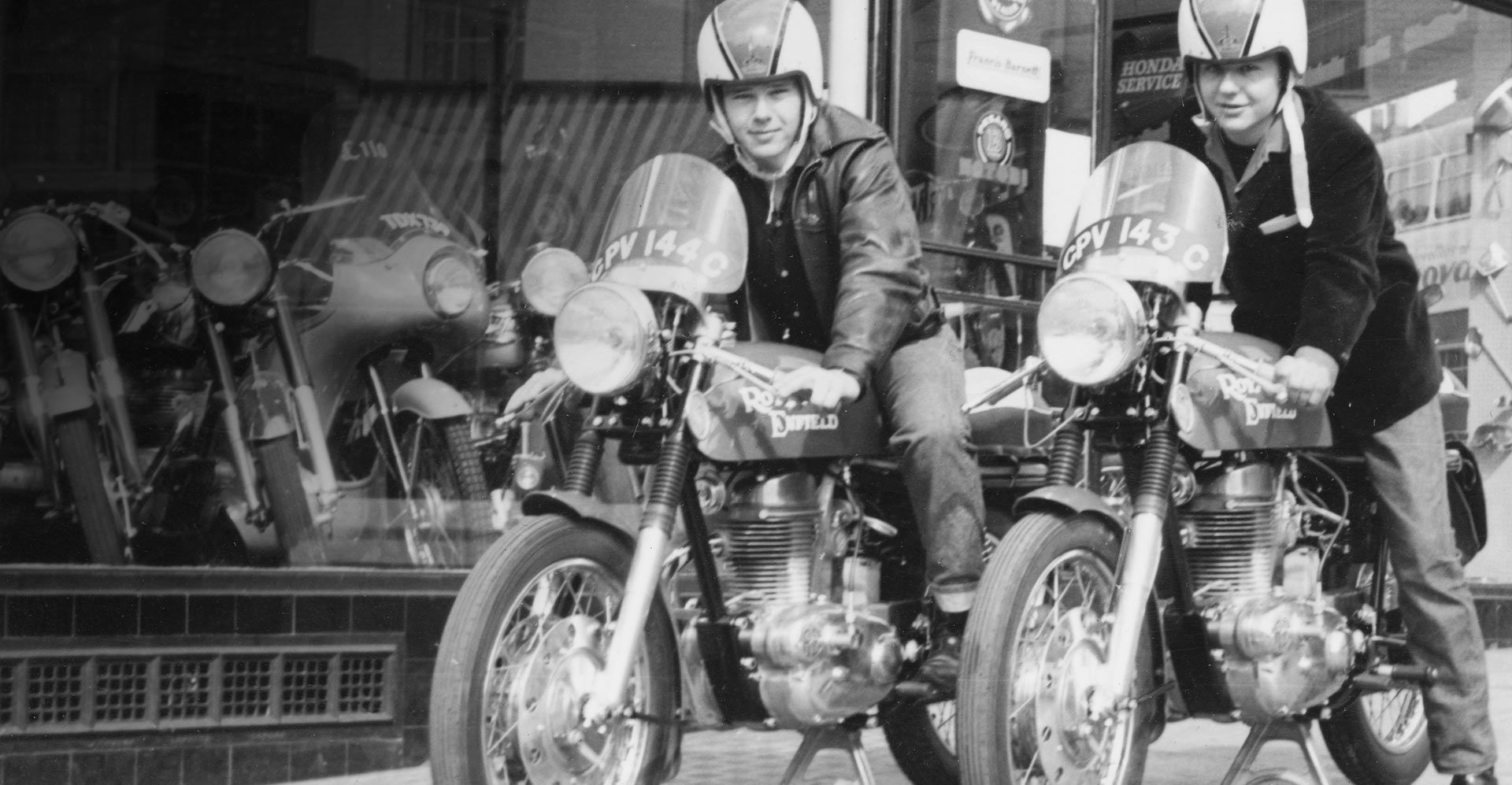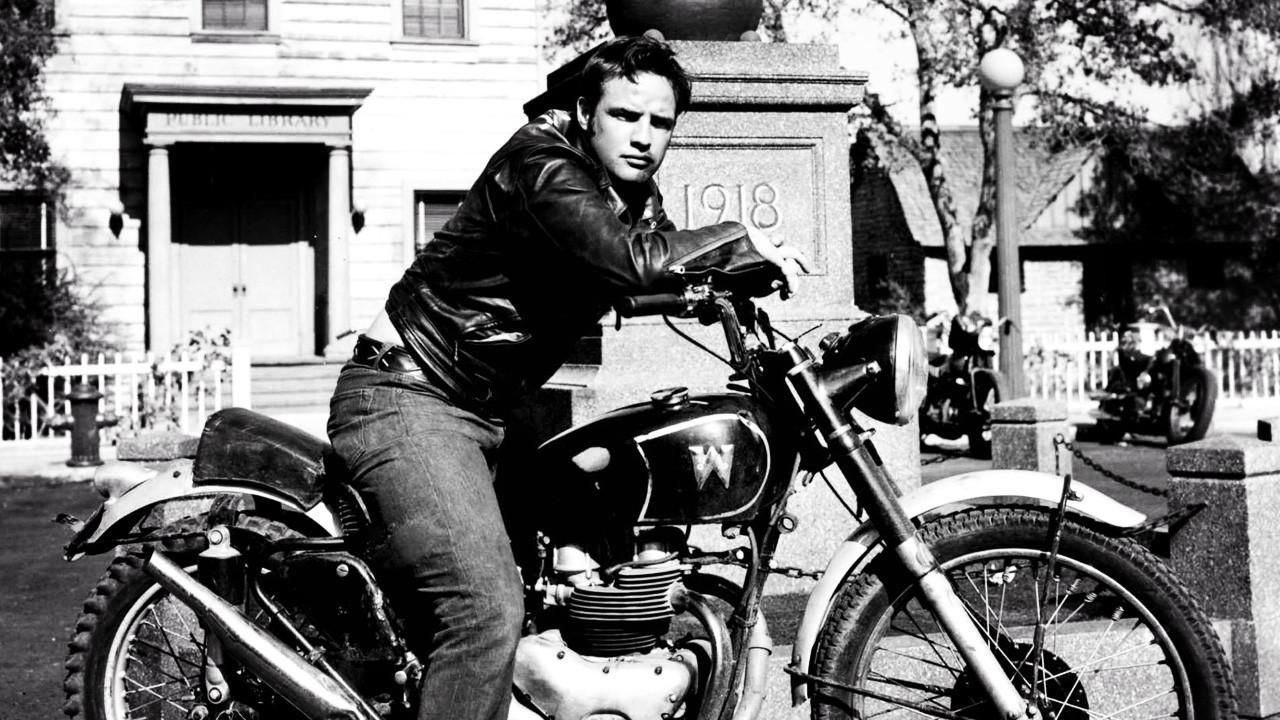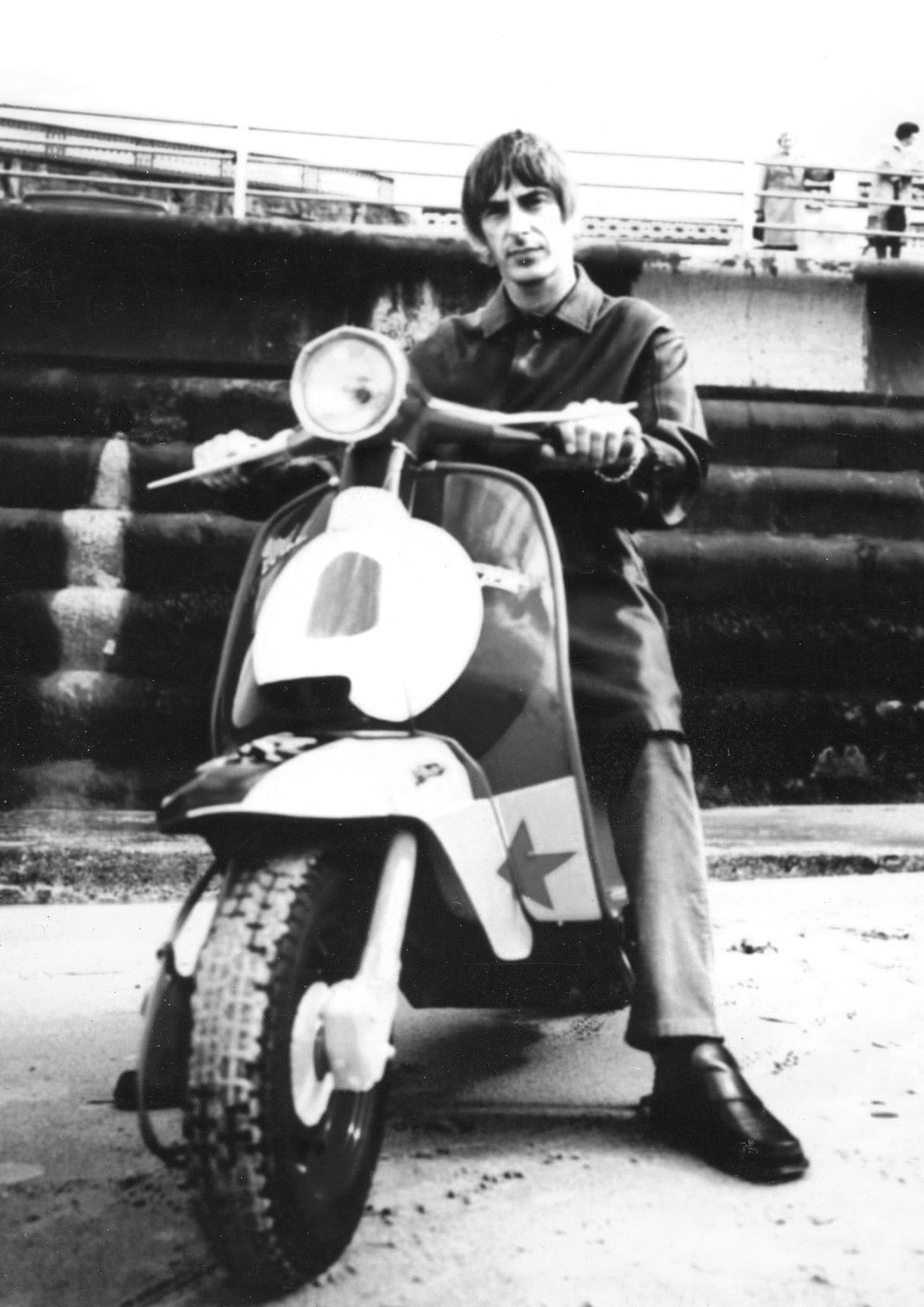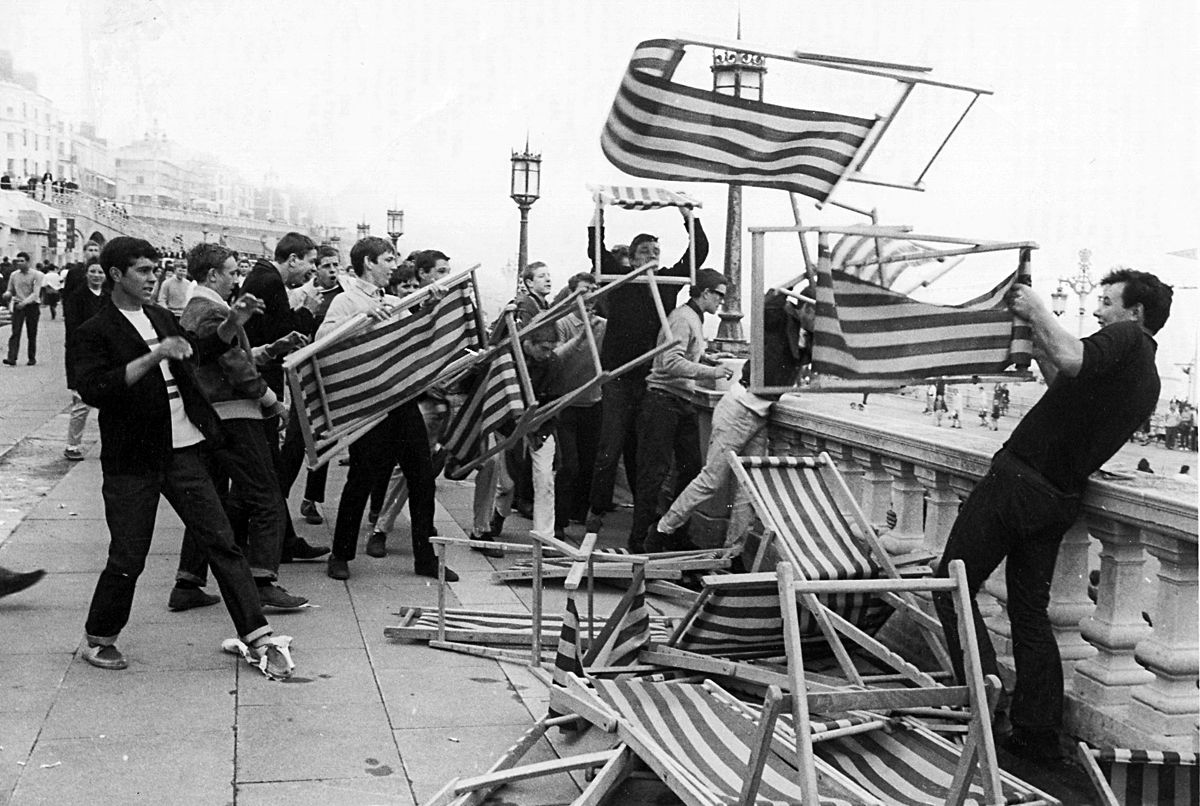Post-war gearheads in the United States made their mark taking pre-war 'jalopies,' chopping them down, and placing modern V8 engines in them to create what we know now as the hot rod. The U.S. had won the war largely through manufacturing, the ability to churn out a massive amount of machinery to overwhelm the Axis, and in peacetime, that power turned to cars and appliances. In England, the landscape was different. The country had been the last line in the war, and its manufacturing, as well as its urban centers, had been extensively bombed. On top of all that, Great Britain simply isn't as large as the United States. It doesn't have the dry lake beds and deserts, the many airstrips, and the open roads. For the youth of post-war Britain, two wheels made more sense than four.
The two-wheeled weapon of choice for British youth depended a lot on who you were and what you listened to. If you were into modern jazz and fashion, you rode a Vespa or Lambretta scooter adorned with mirrors and lights and other accessories. If you were a fan of this new thing called rock 'n roll, you likely hung out at the Ace with your stripped-down Triumph or Norton or BSA hoping to 'do the ton,' racing from one cafe to the next. These were the Mods and the Rockers respectively. They famously didn't get along, so to settle the score, here are ten Mods and their scooters and ten Rockers and their cafe racers.
19 Mod Girl & Her Scooter
Scooters were cheap to buy for the young British kids and offered them freedom and mobility with plenty left over for fashionable clothes and modern jazz records. Fashion was a big part of Mod culture, with the clothing of the Mod being almost as important as the little Italian scooters they rode. Slim-fit suits, long-sleeved polos, and long parkas were among the common clothing choices of Mod culture, along with capri pants for the women who rode their own scooters to the late night clubs and cafes where the Mods would gather. While primarily a scene for affluent post-war youth who had the money to spend on Vespas and jazz records, Mods were an attempt to ascend class. You weren't born a Mod; you dressed like one, and therefore, were one.
18 Rockers & the Leather
In contrast, the rock-&-roll-loving Rockers took their style cues from the United States and rock culture: leather jackets and cuffed pants reminiscent of Marlon Brando in The Wild One. Like their U.S. counterparts, the young British motorcyclists were quickly labeled as rebellious and troubled youth, and the motorcycle's image was one of misguided and potentially violent young people. As Rockers were made up primarily of working-class kids that were doing well in the post-war boom, it became easier to demonize them as 'folk-devils.'
17 Rockers and Minimalism
The Rockers, by contrast, stripped down their bikes. While certainly not above some modification, like this set of dual handlebars for standing on the pegs, Rockers, for the most part, went for a 'less is more' approach.
Predominantly riding on British motorcycles with smaller engines, the goal was to 'hit the ton' or go 100 mph on your motorcycle, contributing to the alternative name for Rockers, the "Ton-Up Boys."
To get that kind of speed, they stripped off anything unnecessary and used 'clip on' handlebars that attached directly to the fork to give them a lower riding profile in the wind. While the quote wasn't yet famous, they followed the Enzo Ferrari rule: whatever is behind you isn't important. Mirrors were commonly removed.
16 Mods and Mirrors
That wasn't a philosophy that the Mods shared. Much like headlights and fog lamps, an array of mirrors was a common Mod addition to their scooters, often making them as wide as the cars of the time, though, in fairness, cars of that time from Britain weren't all that wide with the exception of Jaguars and Rolls-Royces. This was yet another opportunity to add chrome to their rides as well as have a way to get creative in how they mounted those mirrors. Once you're in the realm of four or twelve mirrors, 'why' becomes an increasingly meaningless question. Though Patrick Fousey of the blog Parkas Ave has a very Mod-like response when asked: "I just love to look at myself."
15 Rockers and the Cafe Race
The stripped-down motorcycles of the Rockers were referred to as 'cafe racers,' certainly a common term now with the revival of the cafe racer style. The name comes from the way Rockers fed their need for speed.
Point-to-point races from cafe to cafe or bar to bar were common, but they had another more distinct kind of racing challenge: they would drop a coin in a jukebox and select a tune.
The Rocker would then have to hop on his bike and make it from the cafe to a waypoint and back again before the song ended. This 'record' racing was a way to show off and brag about your bike's speed.
14 Mods & Accessories
Accessorizing their scooters was a popular thing for the Mods. There was no such thing as too much. Extra running lights were a common modification, often involving custom racking to hold them all. Front-end racks were generally meant as extra storage for your gear or whatever you bought down at the shop, but for the Mod, it was a chance to accessorize.
Chrome was also a big deal on a Mod scooter, and the rack and extra lights were a great way to get more shiny chrome on there.
The goal of a Mod was to be seen at the scene—there's no better way to make sure of that than to completely light the way with a dozen or so headlights and fog lamps.
13 Mods and the Two-Tone Paint
One of the easiest and perhaps purist mods without controversy over whether it's really a Mod thing or a scooter thing that Mods adopted is the two-tone paint job. Panels were easy to remove and easy to paint, and the broad, sweeping knee guard made for a great canvas. The most common paint was the two-tone paint job, usually, two contrasting colors like a light and a dark color to really accentuate the differences and highlights. Mod culture has come and gone several times with a different musical subculture attached. While it started out with modern jazz, rock bands like The Jam or The Who embraced the Mod aesthetic as well as Ska, where the two-tone look moved from the scooter to the clothes as well.
12 Rocker Revolution
The Rocker subculture didn't have the same ebb and flow of the Mod culture. While the cafe racer style did go away for a while, it had really just evolved into the sport bike with their more powerful engines and aerodynamic bodywork. Just like rock music began to evolve and diversify, so too did its fans who became prog rockers or punk rockers or hippies or whatever other kind of rock music they liked, including the rock music that was favored by their former rivals, the Mods. Because of that, the revival of the cafe racer aesthetic hasn't been accompanied necessarily by a return of Rocker culture, except simple leather jackets and rolled denim pants. When it comes to Rockers, the cafe racers were really the stars.
11 Mod Parka
Parkas aren't really something you'd think about when it comes to two-wheel action, but for the Mods, it was the coat of choice. First of all, London and Great Britain at large isn't the warmest place on Earth, so a good, cold weather jacket on your two-wheeler isn't the worst idea. Particularly popular were the 'fishtail' parkas. Fishtail parkas were a military parka developed for the US military during the Korean war in 1952. They wanted a coat that didn't impede movement and kept the soldiers warm. The 'fishtail,' the split back, allowed the wearer to wrap both ends around the thighs and stop wind. This, along with the greater length, proved ideal for the Mods to protect their fancy suits, and the parka became a key part of the Mod uniform.
10 The Triton
Rockers modified their cafe racers for speed, taking parts off and adding anything that would get them to that magic 'ton.' Different bikes were better at different things. The Norton featherbed frame was considered the best-handling bike available. The Norton engine, however, had reliability issues when pushed hard. The BSA engine had an architectural problem that made hi-revving performance difficult.
The Triumph engine out of the Bonneville was the strongest and took better to modifications.
So, Rockers would take the engine out of the Triumph Bonneville and put them in the better-handling Norton frame, and the Triton was born. "Tri" from the first letters of "Triumph" and "ton" from the last letters of "Norton," Tritons were a purely custom creation, though some garages would sell the conversion already done for riders without fabricating skills.
9 Mods & the Skellie
When excess reaches the levels Mods had reached with the accessories on their scooters, one of the only ways to stand out is to go in the other direction entirely. Almost taking a page from the Rocker book, some Mods stripped their scooters down to the bare minimum.
These scooters were referred to as "Skellies," slang for 'skeleton scooters.'
Most often associated with the Skinhead contingent of Mods, these scooters removed all the body panels and even would cut down the iconic knee guards. This particular Skellie also features the 'iron board' seat, a tall seat back that was added to the scooter that resembled an ironing board, reminiscent of the sissy bar on U.S. choppers.
8 The Ace Cafe
If there's one place that's indelibly associated with Rockers and the cafe racer, it's the legendary Ace Cafe. Built in the 30s to cater to truckers on the North Circle Road outside of London, the cafe was open 24 hours a day, and the circle road and arterial roads around London were popular with motorcyclists for their chance to open up their bikes. So, the Ace Cafe quickly became a gathering spot for Rockers and their cafe racers. The cafe closed in 1969; however, after a few revival meetings, a group of enthusiasts was able to buy the property and, by 2001, had reopened the full cafe. Today it's still a gathering spot for modern cafe racers and nostalgia seekers.
7 Mod Revivals
While there's no question that cafe racers have had a resurgence, the Mod look and scooter culture have had their moment return as well. Vespas have become collectibles, which have caused a bit of a set of pitfalls for would-be collectors. The Vespa wasn't only popular with Mods; they were also popular in Vietnam and Southeast Asia in general. Where the Vespa was a fashion piece for the Mod, in Vietnam, they were mules. The Vespas brought over from Vietnam for the Mod nostalgist have often been cut together with a patchwork of different scooters and improvised repairs. In California, where these scooters are most prominent, there are mechanics who refuse to work on the Vietnamese scooters.
6 The Racer Look
There are contrasting stories about where all the names came from. For instance, "Rocker" is said by some to refer not to the preferred music of the Rockers but to the rocker arms on their four-stroke engines as opposed to the two-stroke engines on the scooters.
Similarly, the 'cafe racer' moniker referred not to their racing from cafe to cafe but to the bikes being dressed-up racers for riders who only spent their time at cafes looking at their bikes.
As with any movement, youth or otherwise, there were rumors, exaggerations, and detractors. Rockers and Mods alike were the subject of scandalous headlines that reveled in the "moral panic" of a youth culture run rampant.
5 Mod Origins
There's no clear distinction as to when the Mod culture came about. To be sure, the Rocker culture preceded it as an extension of the "Teddy Boys," an adoption of revival Edwardian wear that resembled the Zoot Suits of hipster culture of 1940s USA. Mods drew more inspiration from Beat culture and the modern jazz movement of the time, which was primarily be-bop (small combo jazz played at a lightning pace with an emphasis on technical soloing) and cool jazz (slower jazz with unusual time signatures and unique arrangements). The Mod look and culture eventually followed other forms of music from The Jam and The Who, ska, and modern rock of the '70s, like David Bowie.
4 Royal Enfield
The stars of the cafe racer scene were clearly the big British manufacturers like Norton, Triumph, and BSA. Well-heeled rockers might be able to get their hands on a Vincent, but for the Rocker on a budget, there was the Indian made Royal Enfield: the diminutive 350 Bullet (sold in the US as the "Indian Arrow"). The Enfield actually owed its existence to its brief time owned by BSA. It wasn't for the cycle division. "BSA" stands for "British Small Arms Company," and Enfield made gun parts. However, they had a history with a cycle car and bicycles, and by the time BSA walked away from Enfield, the groundwork was laid for the bullet as a cheap entry motorcycle. The brand eventually went to Norton and shuttered in the '70s. Today, the brand lives on making 500 cc nostalgia bikes.
3 Influence of The Wild One
While it seems like a harsh departure for British Rockers to take their inspiration from U.S. bikers and yet not ride choppers but cafe racers, the chief inspiration, the movie The Wild One, actually makes sense. While the long-forked high-bar chopper eventually became the symbol of U.S. biker culture, The Wild One was more about a rebel racer set. Based loosely on the founding event of the legendary Boozefighter motorcycle club in Hollister, California, the movie depicts the aftermath of the leader of a bunch of fast bikers breaking down a fence during a motocross event to run the course and steal one of the trophies, which Brando uses as a handlebar decoration on his bike. The 1950s film was banned in the UK for fears of corrupting the youth, which made its imagery all the more alluring.
2 Mods at the Beach
Sometimes, a simple paint job is enough for a Mod to make a statement. Beach communities during holidays became a regular spot for the mobile youth of post-war Britain. For much of the early sixties, the Mods weren't the most numerous, and outnumbered, they would often suffer harassment from the older bikers of the Rocker set. For a time, the Rockers and the Mods competed in fear-mongering headlines about rampant youth and the so-called "moral panic." The Mods were members of the post-war baby boom, the largest generation the world had seen, and Britain wasn't prepared for a youth scene this large or this assertive of its own identity.
1 Battle of Brighton Beach 1964
These tensions came to a head during a bank holiday weekend in Brighton Beach. For the first time, the Mods had turned out in numbers, matching the Rockers, and the conflict soon came to a head. The two sides started throwing rocks at each other until fights broke out, summoning large crowds of Rockers and Mods alike to join in or cheer them on. Mods began throwing beach chairs down on the Rockers from above the aquarium while uninvolved tourists ran in a panic from the rolling brawls. Headlines fed the public panic regarding the two warring youth cultures, prompting concerns about young people running rampant. While the older generation held conversations about what to do about them, Rockers and Mods persisted, and the world of youth culture had been born.


